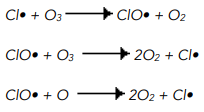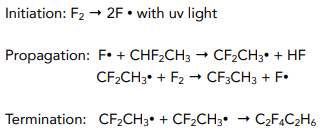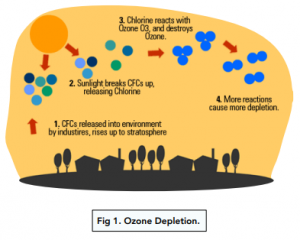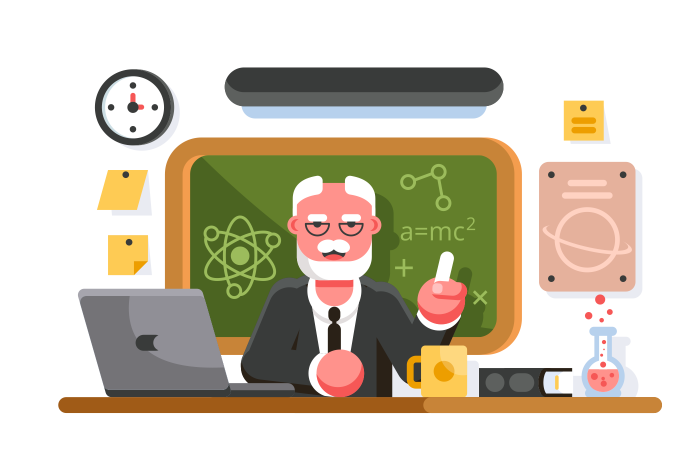Halogenoalkanes - Environmental Impact of Halogenalkanes (A-Level Chemistry)
Environmental Impact of Halogenalkanes
Halogenoalkanes and the Environment
Chlorofluorocarbons (CFCs)
Chlorofluorocarbons or CFCs are halogenoalkanes where all hydrogen atoms have been replaced for chlorine and fluorine atoms.
CFCs such as dichlorodifluoromethane (CF2Cl2), also known as Freon-12, were widely used in aerosol propellants, fridge refrigerants, dry cleaning and air conditioning due to their stable, volatile, nontoxic, non flammable nature.
However, these compounds are no longer used routinely due to their harmful effect on the environment, namely due to their destructive effect on the ozone layer.
Ozone Depletion
Ozone (O3) in the atmosphere is naturally formed from the breakdown of O2 molecules by UV light. This forms oxygen free radicals, which react with other oxygen molecules to form ozone. Therefore, oxygen molecules, oxygen free radicals and ozone molecules exist in equilibrium.
If CFCs are introduced into the atmosphere, they act as a source of Cl free radicals which catalyst the breakdown of the ozone layer via a free-radical mechanism.
The reaction for this (which you need to know off by heart for your examination) is as follows:
1. Initiation – C-Cl bonds in the CFC are broken down homolytically by UV light to form Cl free radicals.

2. Propagation – Cl free radicals react with ozone to form a ClO• intermediate and an oxygen molecule. This intermediate reacts with oxygen radicals in the atmosphere so that the Cl free radical is regenerated and the process starts again.

3. Termination – Two Cl free radicals react to form Cl2 again. The chain reaction stops.

The overall reaction for ozone depletion is O + O3 → O2
Worked example: 1,1-difluoroethane reacts with fluorine in the presence of ultraviolet light. Write the steps in the reaction mechanism.
Answer:

Environmental Risk of Ozone Depletion
Ozone depletion poses an environmental issue as the ozone layer provides protection from UV rays from the sun, and depletion can contribute to the hole in the ozone layer.
The chlorine free radical is able to break down many hundreds of ozone molecules before terminating by reacting with another chlorine free radical.

Ban on Chlorofluorocarbons (CFCs)
Following the discovery of the environmental consequences of CFC use, the Montreal Protocol was endorsed in 1989, where countries agreed to stop using CFCs before the end of the century.
Since then, the scientific community has managed to develop alternatives to CFCs. Some of these are:
- Hydrochlorofluorocarbons (HCFCs) – Still cause atmospheric damage and depletion of the ozone layer but to a lesser extent than CFCs (ozone depletion takes between 10 and 20 years). Furthermore, they are very potent greenhouse gases.
- Hydrofluorocarbons (HFCs) – as they do not contain chlorine atoms, they do not cause damage to the ozone layer but still break down the atmosphere in other ways. Furthermore, they are very potent greenhouse gases.
- Hydrocarbons – Used much less often than the two other compounds. They are mainly used in fridges. They also are greenhouse gases
Although their environmental effects are less damaging than those of CFCs, the use of these alternative still has its drawbacks. As a result, most aerosols nowadays use nitrogen propellants or pump spray systems instead; ammonia is used as refrigerant in fridges ; and carbon dioxide is used in the production of foamed polymers.






Still got a question? Leave a comment
Leave a comment